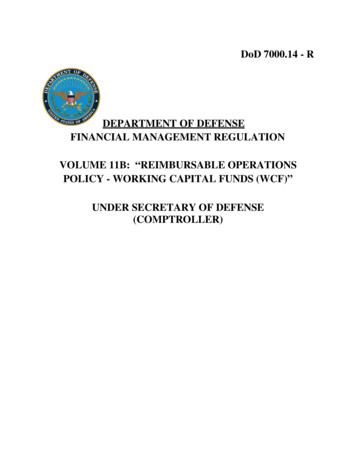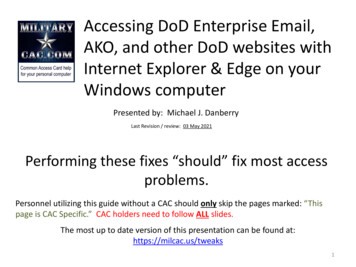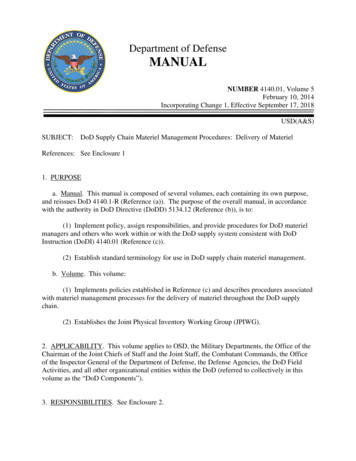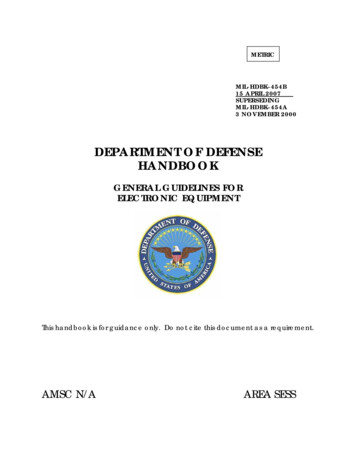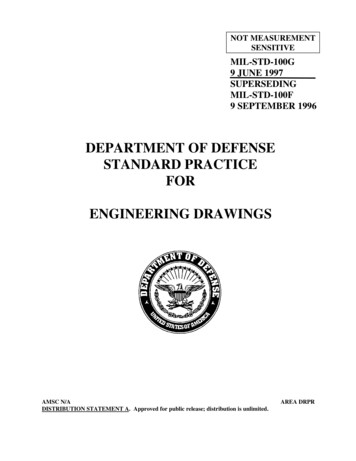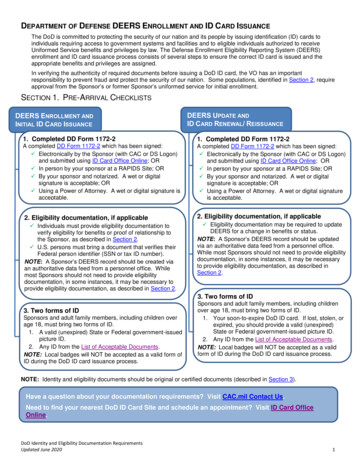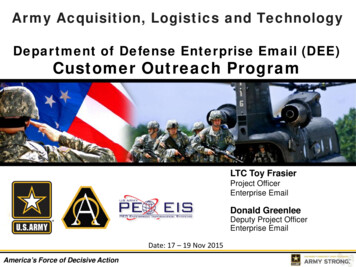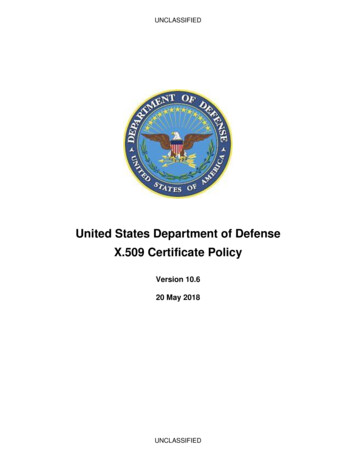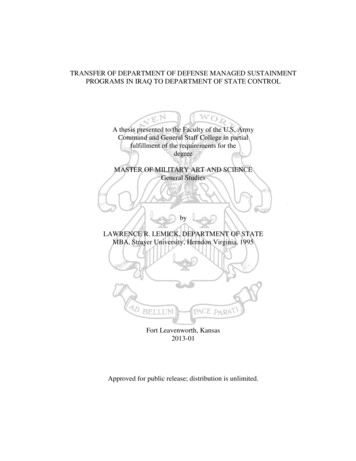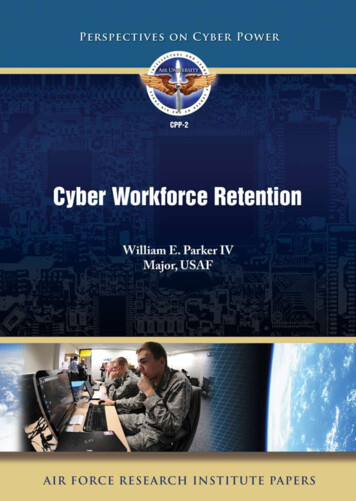Transcription
UNCLASSIFIEDDepartment of Defense (DoD)Information Enterprise ArchitectureMission Partner EnvironmentLEXICONVersion 1.0August 12, 2016Prepared by:Director, Architecture & EngineeringOffice of the DoD Chief Information Officer (CIO)DISTRIBUTION STATEMENT A. Approved for public releaseUNCLASSIFIED
UNCLASSIFIED[This page intentionally left blank]iUNCLASSIFIED
UNCLASSIFIEDSIGNATURE PAGESubmitted By:LAM.NGOAN.THOMAS.1229438960Digitally signed byLAM.NGOAN.THOMAS.1229438960DN: c US, o U.S. Government,ou DoD, ou PKI, ou OSD,cn LAM.NGOAN.THOMAS.1229438960Date: 2016.08.10 13:41:02 -04'00'MR. TOM LAM, GS-15Chief ArchitectMission Partner Environment – Information System (MPE-IS)Deputy Director of Architecture & EngineeringOffice of the Department of Defense Chief Information Officer (DoD CIO)Approved By:KINNEY.RORY.S.1130078733Digitally signed byKINNEY.RORY.S.1130078733DN: c US, o U.S. Government, ou DoD,ou PKI, ou OSD,cn KINNEY.RORY.S.1130078733Date: 2016.08.25 15:58:24 -04'00'MR. RORY KINNEY, SESProject LeadMission Partner Environment – Information System (MPE-IS)Director of Architecture and EngineeringOffice of the Department of Defense Chief Information Officer (DoD CIO)iiUNCLASSIFIED
UNCLASSIFIEDDOCUMENT HISTORYiiiVersionDate0.116 JUL 15POCTom Lam0.227 JUL 15Tom Lam0.331 AUG 15Tom Lam0.40.511 DEC 1514 MAR 16Tom LamTom Lam0.907 APR 16Tom Lam1.012 AUG 16Tom LamBrief DescriptionInitial MS Word formatted draftRedesigned document into 4 Sections, updateddefinitions and streamlined the presentation ofTerm, Definitions, Types, and Acronyms;included comments from 5 sources.Incorporated comments from DoD CIO CS, NGB,CENTCOM, PACOM, NSA, DISA JTSO, MNISOffice, BICES Office, CIAV, and DISA JITC.Plus corrected additional minor formatting errorsin document. The Lexicon was expanded toinclude more system descriptions. 3 Appendiceswere added to better identify the Systems andServices, and to list all the acronyms in onelocation.Prepared the document for formal coordination.Incorporated first round of formal review inputsIncorporates comments from the C/S/Acoordination. Restructures the Lexicon and scalesit back by removing general IT and DoD termsthat are not important to MPE.Incorporates feedback from the final stakeholderreview.Initial release.UNCLASSIFIED
UNCLASSIFIED1 IntroductionTABLE OF CONTENTS. 11.1Purpose and Intended Use . 11.2Initial Development . 11.3Maintaining and Updating the Lexicon . 11.4Use of Sources . 11.5Lexicon Format. 21.6Alphabetical Listing of Terms in the Lexicon . Error! Bookmark not defined.2 Lexicon. 152.162.172.182.192.202.21A-Terms . 2B-Terms . 3C-Terms . 4D-Terms . 11E-Terms . 13F-Terms . 15G-Terms . 17H-Terms . 18I-Terms . 20J-Terms . 21L-Terms . 23M-Terms . 23N-Terms . 32O-Terms . 34P-Terms . 35R-Terms . 36S-Terms . 36T-Terms . 38U-Terms . 40V-Terms . 42Z-Terms . 43Appendix AAPPENDICESList of Acronyms . A-1Appendix BReferences . B-1ivUNCLASSIFIED
UNCLASSIFIED1 IntroductionInformation sharing with mission partners is enabled through a complex web of doctrine, training, andpolicy enabled by programs, systems, and technologies involving hundreds of organizations and manythousands of individuals. Given this complexity and the importance of effective communications tomission success, a consistent, repeatable vocabulary is necessary to minimize miscommunication,misinterpretation, or confusion about the meaning of commonly used terms and phrases. This lexicon isintended to help establish a controlled vocabulary for the use of Mission Partner Environment (MPE) andMPE-related terms across the Department and with our varied mission partners.1.1Purpose and Intended UseThe MPE Lexicon is intended for all operators, maintainers, developers, and other stakeholders (includingmission partners) of the United States (U.S.) Department of Defense (DoD) portion of the global MPE. Itis a mechanism for clearly and consistently communicating the desired intent and effect of the mission/event/exercise commander. The terms and their associated definitions found in the lexicon will be used inall documents and other media related to the DoD portion of the MPE to the greatest extent possible.Unless otherwise stated, the terms and definitions contained in this Lexicon are for the MPE communityonly. The same terms may have different meanings for other communities.1.2Initial DevelopmentThe initial set of Lexicon terms and definitions was collected from multiple DoD and industry sourcesand shaped through a collaborative process involving various DoD components. The Lexicon was scopedto narrowly focus on terms that have a specific meaning within the context of MPE (but may have adifferent meaning in a different context) and terms that are sometimes misused or confused.1.3Maintaining and Updating the LexiconA one-time, static lexicon will not serve the MPE community as new terms will need to be added andexisting terms will need to be modified on a regular basis. For this reason, the DoD Chief InformationOfficer (CIO) will manage the Lexicon through a Public Key Infrastructure-enabled wiki site. Anymember of the MPE community with appropriate credentials will be able to go into the site and usesimple wiki edit techniques to suggest additions, deletions, or modifications. The DoD CIO will reviewand finalize proposed changes on a regular basis. The MPE Lexicon site URL is:https://www.milsuite.mil/wiki/MPE Lexicon1.4Use of SourcesEvery attempt was made to define terms based on recognized, official sources with an establishedpedigree. Sources were chosen based on a number of criteria including applicability to the MPE space,confidence level (as those levels are defined in the Joint Staff J6 AV-2 Development Guide), and date(more recent sources were preferred over older sources). In some cases, a definition was derived from asource (or sources) rather than defined exactly as the source defined it. This was necessary for elementsthat needed to be defined in the context of MPE or for elements where no exact match was found withinthe authoritative sources. In those cases, the source is appended with, “(Derived from:)”. Following, is thehierarchy of sources used in this Lexicon:1)2)3)1U.S. national security sources (e.g., Committee On National Security Systems)Office of the Secretary of Defense (OSD) and Joint Staff sources (e.g., policy issuances,joint publications)Combatant Commands/Military Services/Defense Agencies (CC/S/A) sources (e.g.,architectures, concepts of operations)UNCLASSIFIED
UNCLASSIFIED4)5)6)1.5U.S. Federal sources (e.g., National Institute of Standards and Technology)Industry sources (used as the basis for terms that are widely used in industry)Mission Partner Environment-Information System (MPE-IS) Senior Engineering WorkGroup (WG) or WG documentsLexicon FormatEach entry follows the format shown below:Term (Acronym) – Identifies the word or phrase of interest and its commonly used acronym, if oneexists.Definition – A brief definition of the word or phrase taken from or derived from the listed source(s).Where appropriate the definition is stated in an MPE context rather than a more generalized definitionthat may have a different meaning outside of MPE.Source – The authoritative document(s) from which the definition was taken or derived. Use of thephrase “Derived from” indicates the definition is not an exact word-for-word rendering from a source, butthat the source(s) was used as the primary basis for creating the given definition.See Also – Optional field used to indicate other entries in the Lexicon that are related to the subject entry.Reference – Optional field used to provide additional information on the subject entry such a website.AcknowledgementThe DoD CIO would like to thank the DoD MPE community for their help in developing this lexicon; noproject of this magnitude and importance could have been accomplished by only one organization. Theongoing usefulness of the lexicon will depend upon the willingness of the community to collaborativelyupdate it as the MPE vocabulary evolves over time.2UNCLASSIFIED
UNCLASSIFIED2 Lexicon2.1 A-TermsAfghanistan Mission Network (AMN)DefinitionThe primary Coalition Command, Control, Communications, Computers, Intelligence, Surveillance, andReconnaissance (C5ISR) network in Afghanistan for all International Security Assistance Force (ISAF)forces and operations. It is a federation of networks with the AMN Core provided by North AtlanticTreaty Organization (NATO) and national network extensions provided by contributing nations. TheAMN is operated as a single security domain in order to facilitate information sharing betweenparticipating nations without security boundaries.SourceFuture Mission Network 90-day Study Report, 17 December 2012Agile Virtual Enclave (AVE)DefinitionA Virtual Private Network (VPN) formed using Internet Protocol Security (IPSec) and additional securitymeasures to form the different network security information sharing and data exchange domains across acommon "black core" transport. These virtual enclaves are subject to quality of service allowinginformation packets to be prioritized and routed in accordance with the policy, precedence, andoperational control. Agile Virtual Enclaves can be created and removed quickly, enabling informationsharing and data exchange with unanticipated mission partners and reuse of the full network capability.The preferred general term is Mission Enclave, and the use of the term AVE is typically used inconjunction with Multi-Enclave Clients.SourceU.S. DoD Episodic Mission Partner Environment Joining Instructions, Version 1.10, 11 August 2014See AlsoMission Partner Environment – Information System (MPE-IS) Mission EnclaveMulti-Enclave Client (MEC)AllianceDefinitionThe relationship that results from a formal agreement between two or more nations for broad, long-termobjectives that further the common interests of the members.SourceJoint Publication (JP) 3-0, 11 August 2011See AlsoCoalitionAll Partners Access Network (APAN)DefinitionA web collaboration platform which enables UNCLASSIFIED information exchange between the U.S.DoD and international partners, organizations, agencies, or individuals who do not have access totraditional DoD communication systems. APAN provides a set of shared enterprise Web 2.0 services2UNCLASSIFIED
UNCLASSIFIEDmanaged by the Defense Information Systems Agency (DISA) that combines the benefits of unstructuredcollaboration (wikis, blogs, forums) and structured collaboration (file sharing, calendar) with thepersonalization of social networking.SourceDerived from: Multi-National Information Sharing Program Office overview found on www.disa.milReferenceAPAN Website, www.apan.orgApplication Service Points (ASP)DefinitionA set of servers that support users of a mission enclave with specified application services (e.g., Web,Email, Voice over Internet Protocol (VoIP), Chat).SourceDerived from: DoD Cybersecurity Reference Architecture (CS RA) Version 3.0 (FINAL), 24 September2014 and the Mission Partner Environment – Information System (MPE-IS) Senior Engineering WorkingGroup (SEWG)Asia-Pacific Intelligence Information Network (APIIN)DefinitionUSBICES-X/ Asia-Pacific Intelligence Information Network (APIIN) supports intelligence sharing andintelligence support to operations through bi-lateral and potentially multi-lateral networks. The networkservices include email, VOIP, HD-VTC, and file sharing. The APIIN networks may be connected to theTrusted Network Environment (TNE ) enabling cross domain email and file sharing within agreed uponsharing arrangements.SourceDerived from: USPACOM documentation2.2 B-TermsBattlefield Information Collection and Exploitation Systems (BICES)DefinitionAn intelligence system that allows intelligence data/information sharing among 28 North Atlantic TreatyOrganization (NATO) nations, 7 non-NATO nations; shares information/intelligence in peace and crisis,in bi-lateral and multi-lateral environments; and with national military intelligence organizations. TheBICES Backbone Network (BBN) is funded by the nations. Each nation connects to the BBN forconnectivity to the other NATO nations as well as NATO’s SECRET Wide Area Network (NS WAN)and Headquarters (HQ) NATO’s Minerva network. Connectivity with BICES allows secure Web andEmail with over 65,000 NATO and national users and Secure Voice or Video with over 700 usersworldwide. BICES operates at the NATO SECRET classification level. BICES maintains Cross DomainSolutions (CDS) that enable data to be passed to seven participating non-NATO nations, includingAustralia, Austria, Finland, Ireland, New Zealand, Sweden, and Switzerland.SourceU.S. Battlefield Information Collection and Exploitation Systems (BICES) Service Catalog v3.0,Battlefield Information Collection and Exploitation Systems (BICES) 2014 Service Catalogue3UNCLASSIFIED
UNCLASSIFIEDSee AlsoU.S. Battlefield Information Collection and Exploitation SystemsU.S. Battlefield Information Collection and Exploitation Systems - ExtendedBlack CoreDefinitionA communication network architecture in which user data traversing a global Internet Protocol (IP)network is end-to-end encrypted at the IP layer. Related to striped core.SourceCommittee on National Security Systems Instruction (CNSSI) No. 4009, 6 April 2015Black TransportDefinitionA network environment (point-to-point and multi-point) supporting end-to-end encrypted information at asingle classification level; networks within the environment are segmented by network technology withinspection points at the perimeter, boundary, or gateway. Encrypted traffic is routed, switched, orforwarded over an UNCLASSIFIED or untrusted network infrastructure, which may or may not becontrolled by the DoD.SourceJoint Information Environment (JIE) Network Normalization and Transport (NNT) Integrated DesignTeam (IDT) Wide Area Network (WAN) Solution Architecture2.3 C-TermsCapabilities/Limitations, Operational Impacts (CAPs/LIMs, OIs)DefinitionCapabilities (CAPs) - The ability of a mission thread (MT) service to support the minimum operationalrequirement (MOR) for the MT during execution of an operational mission.Limitations (LIMs) - The areas in which an MT service fails to support the MOR and MinimumImplementation (MINIMP) for MTs in the execution of an operational mission.Operational Impacts (OI) - The effect upon the operational commander’s ability to conduct his missionresulting from the identified capabilities and limitations identified from the analysis of the MOR andMINIMP.SourceCoalition Interoperability Assurance and Validation (CIAV) Mission Profiles Implementation StrategyCENTCOM Partner Network (CPN)DefinitionA “network of networks” utilizing U.S. and coalition networks to establish an enduring regional partnernetwork for command and control (C2), secure communication, information sharing, and coordinationbetween USCENTCOM, our service components and assigned JTF’s and regional partners operating atthe strategic/operational level.SourceUSCENTCOM Update to Coalition Capability Exchange Meeting (CCEM), 3 December 2014Coalition4UNCLASSIFIED
UNCLASSIFIEDDefinitionA coalition is an arrangement between two or more nations for common action. Coalitions are typicallyad hoc, formed by different nations, often with different objectives, usually for a single event or for alonger period while addressing a narrow sector of common interest. Operations conducted with units fromtwo or more coalition members are referred to as coalition operations.SourceDerived from: Joint Publication 1-02, 15 June 2015 and Joint Publication 3-16Coalition Interoperability Assurance and Validation (CIAV)DefinitionA mission-based interoperability methodology that maps the end-to-end flow of information andexchange of data, assisting in the overall improvement, streamlining, and integration of processesinvolving operational and technical exchange requirements aligned to specific mission needs. Themethodology results in fit for purpose determinations.The process carried out by CIAV to analyz
Aug 12, 2016 · Chief Architect . Mission Partner Environment – Information System (MPE-IS) . phrase “Derived from” indicates the definition is not an exact word-for-word rendering from a source, but that the source(s) was use
